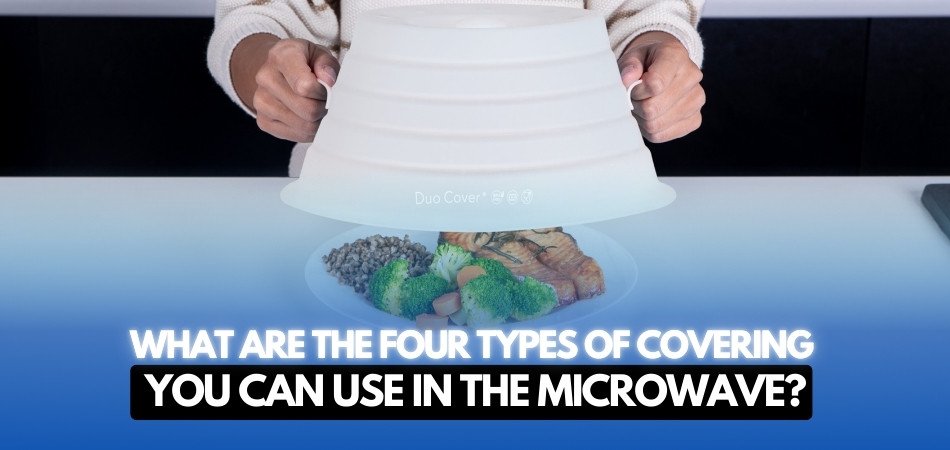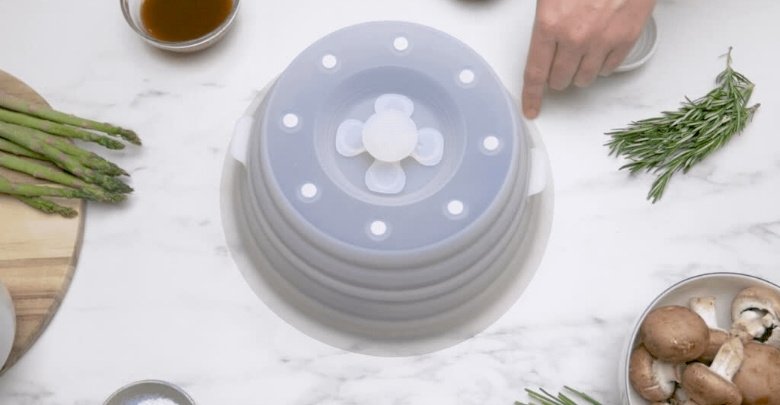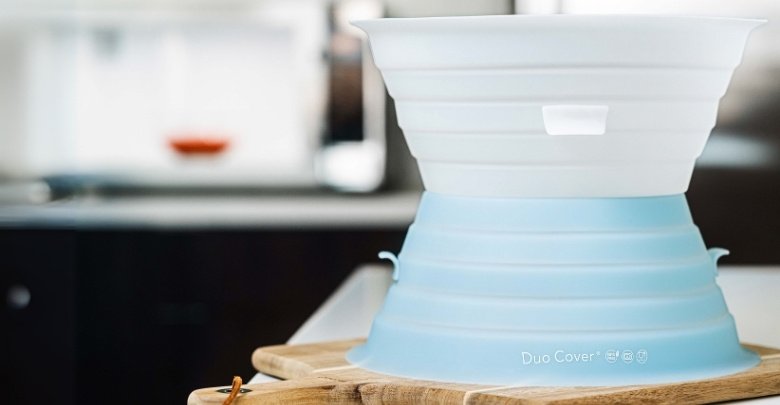Microwaving food is a quick and convenient way to prepare meals, but ensuring your food cooks evenly and doesn’t create a mess can be a challenge. One simple solution is using a proper covering to help retain moisture, prevent splatters, and promote even cooking. But, what are the four types of covering you can use in the microwave?
The four types of covering you can use in the microwave are microwave-safe plastic wrap, waxed paper, microwave-safe paper towels, and microwave-safe plastic lids or plates. These covers are designed to be safe and effective, ensuring that your microwave remains clean and your food is correctly heated.
If you would like to find out more about each of these covers and how you can use them, keep reading the following section of this article.
What Are the Four Types of Covering You Can Use in the Microwave? (Safe Choices)
Microwaving your food can save time, but doing it right makes all the difference. Using the right cover helps heat food evenly and safely. Let’s explore the best options you can use to cover your food in the microwave:

Microwave-Safe Plastic Wrap
Plastic wrap is a common kitchen item used to seal and cover food. When labeled microwave-safe, it’s designed to withstand high heat. It traps steam, helping food stay moist and cook evenly. Always make sure the wrap doesn’t touch the food directly.
This type of covering works best for reheating leftovers and steaming vegetables. It keeps the microwave free of food splatters and spills. Leave a small corner open to let steam escape safely. Never use regular plastic wrap, as it may melt or release harmful chemicals.
Waxed Paper
Waxed paper is a lightweight, non-stick covering used in many kitchens. It’s coated with a thin layer of wax on both sides. In the microwave, it acts as a barrier to stop food from splattering. It also lets steam escape, preventing sogginess.
You can place waxed paper loosely over dishes to keep moisture in. It’s ideal for reheating items like pizza or baked goods. This paper doesn’t trap as much heat as plastic wrap, so it’s great for lighter heating. Avoid using waxed paper with very oily foods to prevent stains or burns.
Microwave-Safe Paper Towels
Paper towels are another handy covering option for microwave use. They’re great for preventing splatters and absorbing excess moisture. Make sure the towels are labeled microwave-safe before using them. Not all paper towels are designed to handle heat safely.
Use one or two layers over food to stop sauces and liquids from splashing. They’re especially helpful when reheating fried foods or greasy meals. Paper towels help keep food crisp by absorbing steam. Don’t use printed or colored towels, as the ink may transfer.
Microwave-Safe Lids or Plates
Microwave-safe lids or inverted plates work well for covering bowls and containers. They create a dome effect that traps heat and moisture. This promotes even heating and prevents dry spots in your food. Always leave a gap or vent to release steam safely.
These lids are reusable and environmentally friendly compared to disposable options. Some come with built-in vents for better air circulation. Using a plate or lid also protects your microwave’s interior from messy splatters. Just ensure it’s labeled safe for microwave use before placing it inside.
Using the right covering in the microwave helps your food cook evenly, stay moist, and keeps your appliance clean. From plastic wrap to reusable lids, each option serves a unique purpose in the kitchen. Also, you can consider the Duo Cover, which has gained popularity in the market, offering a reusable and user-friendly solution. Try different covers and see which one fits your cooking style best for safer and cleaner microwave use.
Why is Using a Cover in the Microwave a Good Idea?
You might think that using a cover in the microwave is a small thing, but it actually helps a lot. It keeps things clean and your food cooks better. Many people skip it without knowing why it really matters. Here’s how a cover can make a big difference.

Stops Food Splatter
Microwaves heat food fast, and that can make sauces or soups pop and splatter. Without a cover, your microwave can get super messy in just one use. Cleaning those dried-up bits is no fun at all. A simple cover can stop all that mess from happening. It keeps things tidy and saves cleaning time later.
Helps Food Cook Evenly
When you use a cover, it helps the heat stay around the food. This means your food heats up more evenly and quickly. Without a cover, the edges might get hot, but the middle stays cold. That’s not fun when you bite into something half-warm. Using a cover just helps everything cook better.
Keeps Food Moist
Sometimes, food gets dry or hard after microwaving it. That’s because moisture escapes while it’s heating. A cover traps some of that steam and keeps your food soft and moist. It’s especially good for rice, pasta, or leftovers. So, your food stays tasty instead of turning dry and chewy.
Prevents Bad Smells
Some foods leave strong smells after being microwaved. A cover helps stop those smells from spreading all over the place. It keeps the food’s aroma inside the dish, where it belongs. Your kitchen will smell better, especially when you’re reheating strong-smelling foods. Nobody wants a microwave that smells like last night’s fish.
Saves Time and Effort
Cleaning a messy microwave takes time and effort you don’t always have. Using a cover means less mess, so less cleaning. You won’t need to scrub the inside every day. It also saves time when you’re in a rush. Just pop the cover on and go.
Easy and Cheap
Microwave covers are simple to use and don’t cost much. You can use things like wax paper, paper towels, or a plastic lid. Most of these are already in your kitchen. They’re a small part of safe and healthy microwave use that anyone can follow. Just grab one and use it whenever you heat something.
Is Plastic Wrap Really Safe in the Microwave?
Many people wonder if using plastic wrap in the microwave is okay or not. It’s something we often grab without thinking twice. But not all plastic wrap is safe for microwave use. Some can melt or release harmful stuff when heated with food.
Always check the label before using plastic wrap in the microwave. Look for one that says “microwave-safe” to be sure it’s okay. These types are made to handle heat without melting or causing problems. It’s also smart to keep the plastic from touching the food directly while heating.
Leaving a small gap or vent helps steam escape and avoids too much pressure. That makes it safer and helps heat your food evenly. Using microwave-safe plastic wrap the right way is part of safe cooking. When used carefully, it can be a helpful and easy option.
Common Microwave Cover Mistakes to Avoid
Microwaving food seems simple, but small mistakes can lead to mess, uneven heating, or even safety risks. Many of these problems come from how we cover our food. Let’s look at the common microwave cover mistakes you should avoid.
- Using Non-Microwave-Safe Plastic: Some plastics can melt or release harmful chemicals into your food when heated. Always check labels for microwave-safe signs before using plastic.
- Sealing Covers Too Tightly: Tight covers trap steam, causing pressure to build and possibly pop off. Always leave a small vent to release steam safely.
- Letting Plastic Touch the Food: Plastic wrap touching hot food can melt or stick to it. Keep some space between the wrap and the food surface.
- Using Metal or Foil as a Cover: Metal and foil reflect microwave energy and can spark or damage the microwave. Never use these materials to cover food.
- Skipping a Cover Altogether: No cover means food splatter all over the microwave’s inside. Cleaning that mess is annoying and easily avoidable with a simple cover.
- Using Printed Paper Towels: Printed or colored paper towels might contain dyes that release chemicals. Choose plain white paper towels labeled safe for microwave use.
- Reusing Damaged Covers: Cracked or warped plastic lids can become unsafe with heat. Replace damaged covers to avoid melted plastic or uneven heating.
- Covering for Too Long: Leaving food covered for too long traps too much heat. This can dry out the food or make it overcooked on the edges.
When to Replace Your Microwave Food Covers?
Food covers for microwaves do not last forever, even when they appear to be in good condition. Over time, they can wear out or stop working properly. Replacing them at the right time helps keep food safe and your microwave clean. Here are some signs that it’s time for a new one.

Cracks or Breaks
A cover with cracks can break completely while heating. Broken pieces might fall into your food, which isn’t safe. Cracks also let steam escape, making it less useful. A strong, clean cover works better for cooking. Don’t wait too long to switch it out.
Warped Shape
Covers often lose their shape from too much heat or rough handling. A bent cover won’t sit right on your dish. This leads to steam escaping and uneven heating. A proper fit keeps food cooking the way it should. When the shape changes, it’s best to get a new one.
Stained or Discolored
Some foods leave behind strong stains or smells that never wash out. Even regularly cleaning microwave food covers won’t always remove deep discoloration or odors. This is usually a sign the plastic is breaking down. Old, stained covers may not be safe to keep using. A fresh one keeps things clean and healthy.
Loose or Missing Vents
Microwave covers with vents help let out steam safely. When a vent is broken or missing, it can cause the cover to pop off. That makes heating food messy and unsafe. A good vent means safer and more even cooking. Replace the cover when the vent no longer works.
Doesn’t Fit Well
Covers that slide around or leave big gaps don’t work well. They let steam and heat escape, making cooking less effective. A cover should fit neatly over your bowl or plate. When it no longer fits right, it’s time to replace it. Cooking gets easier with the right cover.
Used for Too Long
Using the same cover for years can wear it out. The plastic can weaken and start to melt or smell weird. Even when it looks okay, it might not be safe anymore. It’s smart to switch to a new one after regular use. Better safe than sorry.
Top Tips to Choose the Best Microwave Cover for Your Food
Microwave covers affect how your food cooks and how clean your microwave stays. A good one should fit your needs, be safe, and be easy to use. Here are some simple tips to help you pick the right one.
- Check for Microwave-Safe Label: Make sure the cover is clearly marked as microwave-safe on the packaging. This helps avoid melting, warping, or releasing harmful chemicals.
- Pick the Right Size: Choose a cover that fits over your regular bowls and plates. A proper fit stops splatter and holds in heat better.
- Look for Steam Vents: Steam vents help let out extra heat while cooking. They stop pressure from building and keep your food from getting soggy.
- Go for Easy Cleaning: Select a cover that’s simple to wash or dishwasher safe. This saves time and keeps your microwave cover fresh and clean.
- Avoid Metal Parts: Covers with metal trim or parts are unsafe for microwaving. Metal can cause sparks, damage the microwave, or even start fires.
- Pick Durable Material: Strong plastic or silicone lasts longer under heat. A thick, quality cover won’t crack or warp after repeated use in the microwave.
- Choose Clear Designs: Clear or see-through covers let you check your food without removing them. This makes it easier to avoid overcooking or drying out food.
- Foldable or Stackable Option: Covers that fold or stack save space in your kitchen. They’re great for smaller kitchens and keep your shelves less cluttered.
FAQs About the Four Types of Covering You Can Use in the Microwave?
In this section, we’ll answer some common questions people have about using covers in the microwave. Whether you’re new to microwaving or just want to know more about how to cover food properly, we’ve got you covered.
Is It Okay to Cover Food with a Ceramic Plate?
Using a ceramic plate as a microwave cover is usually safe and common. Make sure the plate is microwave-safe and not too heavy. Leave a small gap for steam to escape and avoid pressure buildup. Avoid plates with metal trim or decorative elements.
What Happens If I Don’t Vent the Cover?
Not venting a microwave cover can cause steam to build up, which might lead to the cover popping off or food overheating. This can also result in uneven heating or soggy food. Most covers need a small opening to let steam escape safely. A quick lift or a built-in vent works best.
How Long Can You Microwave with a Cover On?
Microwave covers can usually be used for any duration as long as the material is microwave-safe and steam can escape. Extended heating should be done with care to avoid overheating or drying out food. Always follow the cover manufacturer’s instructions. Also, pause and check the food during longer heating sessions.
Should You Cover Soup in the Microwave?
Yes, soups should always be covered to avoid messy splatters and promote even heating. Use a loose lid or vented cover so steam can escape. This helps retain the soup’s moisture and heats it more evenly. Avoid tightly sealing the container, as pressure can build up.
Can You Microwave Food Without a Cover at All?
While you can microwave food without a cover, it often leads to splattering and uneven heating. Covering food helps trap steam and cook it better. It also keeps your microwave cleaner, saving you time later. Using a simple cover is always a smart idea.
Why Does My Cover Pop Off in the Microwave?
Covers can pop off if steam builds up too much and there’s no vent for it to escape. This can be avoided by using vented lids or leaving a small gap. Overheating the food may also increase pressure inside. Make sure to watch cooking times and leave space.
Bottom Line
You can make a significant difference in the way your food cooks and how clean your microwave stays by choosing the right cover. Covers help prevent splatters, keep food moist, and allow heat to spread more evenly.
So, what are the four types of covering you can use in the microwave? You can use microwave-safe plastic wrap, wax paper, paper towels, and plastic lids or plates. Each option has its own use and benefits, depending on the food you’re heating.
Just remember to avoid common mistakes, like using unsafe plastics or sealing too tightly. Replacing worn-out covers and picking the right ones keeps things simple and safe. With the right choice, microwave cooking becomes easier, cleaner, and better.






